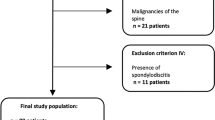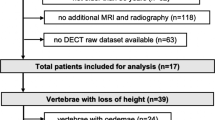Abstract
Objectives
To evaluate the diagnostic accuracy of single-source dual-energy computed tomography (DECT) for the detection of bone marrow oedema (BME) in patients with vertebral compression fractures.
Methods
Patients over 50 years of age with radiographically suspected vertebral compression fracture of the thoracic or lumbar spine were prospectively enrolled. All patients underwent DECT with sequential acquisition of 80 and 135 kVp datasets on a 320-row detector CT scanner and 1.5-Tesla magnetic resonance imaging (MRI) including T1-weighted and short-tau inversion recovery (STIR) sequences. Virtual non-calcium (VNCa) images were reconstructed using a three-material decomposition algorithm. Vertebrae with height loss in CT were scored for the presence of BME in both MRI and DECT and used to determine signal- and contrast-to-noise ratios (SNR and CNR). Contingency analysis using MRI as standard of reference and Fleiss’s kappa were calculated. IRB approval was obtained.
Results
In total 192 vertebral compression fractures in 70 patients (23 men, 47 women; mean age 70.7 years (SD 9.8)) were included in our analysis. DECT showed a reader-dependent sensitivity of 72% and specificity of 70% for BME. Fleiss’s kappa was .40 for DECT and .58 for MRI. T1-weighted images had significantly better SNR and CNR compared to STIR, CT, and VNCa (p < .0001); however, there was no difference between STIR and VNCa.
Conclusions
VNCa images depict BME with adequate sensitivity and specificity and can be acquired on a single-source system. Image quality is adequate but trained readers are needed for image interpretation.
Key Points
• Dual-energy CT in a single-source technique can help to detect bone marrow oedema in patients with vertebral compression fractures.
• However, given the inferior inter-rater reliability and limited specificity compared to MRI, experienced readers are needed for image interpretation.
• Dual-energy CT of the spine has limited sensitivity for the detection of bone marrow oedema in vertebra with previous surgical intervention.




Similar content being viewed by others
Abbreviations
- BME:
-
Bone marrow oedema
- CNR:
-
Contrast-to-noise ratio
- DECT:
-
Dual-energy computed tomography
- IVR:
-
Intervertebral ratio
- SD:
-
Standard deviation
- SNR:
-
Signal-to-noise ratio
- STIR:
-
Short-tau inversion recovery
- VNCa:
-
Virtual non-calcium reconstruction
References
Hiligsmann M, Neuprez A, Buckinx F, Locquet M, Reginster JY (2017) A scoping review of the public health impact of vitamin D-fortified dairy products for fracture prevention. Arch Osteoporos 12:57
Kyriakos G, Vidal-Casariesgo A, Quiles-Sanchez LV et al (2016) Osteoporosis management in a real clinical setting: heterogeneity in intervention approach and discrepancy in treatment rates when compared with the NOGG and NOF guidelines. Exp Clin Endocrinol Diabetes 124:466–473
Cunningham TD, Martin BC, DeShields SC, Romero CC (2016) The impact of osteoporotic fractures compared with other health conditions in older adults living in Virginia, United States. Osteoporos Int 27:2979–2988
Cauley JA, Lui LY, Paudel ML et al (2016) Impact of radiographic vertebral fractures on inpatient healthcare utilization in older women. Bone 88:165–169
Jackson SA, Tenenhouse A, Robertson L (2000) Vertebral fracture definition from population-based data: preliminary results from the Canadian Multicenter Osteoporosis Study (CaMos). Osteoporos Int 11:680–687
Ensrud KE, Thompson DE, Cauley JA et al (2000) Prevalent vertebral deformities predict mortality and hospitalization in older women with low bone mass. Fracture Intervention Trial Research Group. J Am Geriatr Soc 48:241–249
Garfin SR, Buckley RA, Ledlie J (2006) Balloon kyphoplasty for symptomatic vertebral body compression fractures results in rapid, significant, and sustained improvements in back pain, function, and quality of life for elderly patients. Spine (Phila Pa 1976) 31:2213–2220
Sander AL, Laurer H, Lehnert T et al (2013) A clinically useful classification of traumatic intervertebral disk lesions. AJR Am J Roentgenol 200:618–623
Dudli S, Ferguson SJ, Haschtmann D (2014) Severity and pattern of post-traumatic intervertebral disc degeneration depend on the type of injury. Spine J 14:1256–1264
Campbell SE, Phillips CD, Dubovsky E, Cail WS, Omary RA (1995) The value of CT in determining potential instability of simple wedge-compression fractures of the lumbar spine. AJNR Am J Neuroradiol 16:1385–1392
McConnell CT Jr, Wippold FJ 2nd, Ray CE Jr et al (2014) ACR appropriateness criteria management of vertebral compression fractures. J Am Coll Radiol 11:757–763
Wong CC, McGirt MJ (2013) Vertebral compression fractures: a review of current management and multimodal therapy. J multidiscip healthc 6:205–214
McCarthy J, Davis A (2016) Diagnosis and Management of Vertebral Compression Fractures. Am Fam Physician 94:44–50
Emery DJ, Forster AJ, Shojania KG, Magnan S, Tubman M, Feasby TE (2009) Management of MRI Wait Lists in Canada. Healthc Policy 4:76–86
Nicolaou S, Liang T, Murphy DT, Korzan JR, Ouellette H, Munk P (2012) Dual-energy CT: a promising new technique for assessment of the musculoskeletal system. AJR Am J Roentgenol 199:S78–S86
De Cecco CN, Schoepf UJ, Steinbach L et al (2017) White paper of the society of computed body tomography and magnetic resonance on dual-energy CT, part 3: vascular, cardiac, pulmonary, and musculoskeletal applications. J Comput Assist Tomogr 41:1–7
Reagan AC, Mallinson PI, O'Connell T et al (2014) Dual-energy computed tomographic virtual noncalcium algorithm for detection of bone marrow edema in acute fractures: early experiences. J Comput Assist Tomogr 38:802–805
Petritsch B, Kosmala A, Weng AM et al (2017) Vertebral compression fractures: third-generation dual-energy CT for detection of bone marrow edema at visual and quantitative analyses. Radiology 284:161–168
Karaca L, Yuceler Z, Kantarci M et al (2016) The feasibility of dual-energy CT in differentiation of vertebral compression fractures. Br J Radiol 89:20150300
Bierry G, Venkatasamy A, Kremer S, Dosch JC, Dietemann JL (2014) Dual-energy CT in vertebral compression fractures: performance of visual and quantitative analysis for bone marrow edema demonstration with comparison to MRI. Skeletal Radiol 43:485–492
Wang CK, Tsai JM, Chuang MT, Wang MT, Huang KY, Lin RM (2013) Bone marrow edema in vertebral compression fractures: detection with dual-energy CT. Radiology 269:525–533
Gondim Teixeira PA, Gervaise A, Louis M et al (2015) Musculoskeletal wide detector CT: principles, techniques and applications in clinical practice and research. Eur J Radiol 84:892–900
Diekhoff T, Hermann KG, Pumberger M, Hamm B, Putzier M, Fuchs M (2017) Dual-energy CT virtual non-calcium technique for detection of bone marrow edema in patients with vertebral fractures: A prospective feasibility study on a single- source volume CT scanner. Eur J Radiol 87:59–65
Genant HK, Wu CY, van Kuijk C, Nevitt MC (1993) Vertebral fracture assessment using a semiquantitative technique. J Bone Miner Res 8:1137–1148
Foley WD, Shuman WP, Siegel MJ et al (2016) White Paper of the Society of Computed Body Tomography and Magnetic Resonance on Dual-Energy CT, Part 2: Radiation Dose and Iodine Sensitivity. J Comput Assist Tomogr 40:846–850
Tao SM, Li X, Schoepf UJ et al (2018) Comparison of the effect of radiation exposure from dual-energy CT versus single-energy CT on double-strand breaks at CT pulmonary angiography. Eur J Radiol 101:92–96
Fuchs M, Putzier M, Pumberger M, Hermann KG, Diekhoff T (2016) Acute vertebral fracture after spinal fusion: a case report illustrating the added value of single-source dual-energy computed tomography to magnetic resonance imaging in a patient with spinal Instrumentation. Skeletal Radiol 45:1303–1306
Li M, Qu Y, Song B (2017) Meta-analysis of dual-energy computed tomography virtual non-calcium imaging to detect bone marrow edema. Eur J Radiol 95:124–129
Kaup M, Wichmann JL, Scholtz JE et al (2016) Dual-energy CT-based display of bone marrow edema in osteoporotic vertebral compression fractures: impact on diagnostic accuracy of radiologists with varying levels of experience in correlation to MR imaging. Radiology 280:510–519
Suh CH, Yun SJ, Jin W, Lee SH, Park SY, Ryu CW (2018) Diagnostic performance of dual-energy CT for the detection of bone marrow oedema: a systematic review and meta-analysis. Eur Radiol. https://doi.org/10.1007/s00330-018-5411-5
Funding
The Department of Radiology at Charité – Universitätsmedizin Berlin received a research grant by Canon MS. Canon MS provided the software for image-evaluation. The study itself did not received any funding.
Author information
Authors and Affiliations
Corresponding author
Ethics declarations
Guarantor
The scientific guarantor of this publication is Torsten Diekhoff.
Conflict of interest
The authors of this article declare relationships with the following companies: JM is an employee of Canon MS.
Statistics and biometry
Andrea Stroux kindly provided statistical advice for this manuscript.
Informed consent
Written informed consent was obtained from all subjects (patients) in this study.
Ethical approval
Institutional Review Board approval was obtained.
Methodology
• prospective
• cross-sectional study/diagnostic study
• performed at one institution
Electronic supplementary material
ESM 1
(DOCX 4308 kb)
Rights and permissions
About this article
Cite this article
Diekhoff, T., Engelhard, N., Fuchs, M. et al. Single-source dual-energy computed tomography for the assessment of bone marrow oedema in vertebral compression fractures: a prospective diagnostic accuracy study. Eur Radiol 29, 31–39 (2019). https://doi.org/10.1007/s00330-018-5568-y
Received:
Revised:
Accepted:
Published:
Issue Date:
DOI: https://doi.org/10.1007/s00330-018-5568-y




